INCREASING OF DIESEL EFFICIENCY OF SHUNTING DIESEL LOCOMOTIVES, OPERATING ON RAILWAYS OF THE REPUBLIC OF KAZAKHSTAN
Абдуллаев С.С.1, Токтамысова А.Б.2, Бакыт Г.Б.3
1ORCID: 0000-0002-1825-0097, Доктор технических наук,
2ORCID: 0000-0002-1825-0023, Кандидат технических наук,
3ORCID: 0000-0002-1825-0097, Старший преподаватель,
Казахская академия транспорта и коммуникаций имени М. Тынышпаева в г. Алматы
ПОВЫШЕНИЕ ТОПЛИВНОЙ ЭКОНОМИЧНОСТИ МАНЕВРОВЫХ ТЕПЛОВОЗОВ, ЭКСПЛУАТИРУЕМЫХ НА ЖЕЛЕЗНЫХ ДОРОГАХ РЕСПУБЛИКИ КАЗАХСТАН
Аннотация
Работа посвящена решению вопросов, связанных с определением в зависимости от условий эксплуатации маневровых локомотивов на разных станциях и выбора их основных технических параметров, требующие сложные технико-технологические и аналитические исследования. Статья посвящена проблеме увеличения эксплуатационного расхода топлива маневровых тепловозов в холодное время года. Рассматриваются возможные пути решения данной проблемы путем применения дизелей с сухим картером. Приведена методика оценки теплового состояния дизеля и расчета расхода топлива котла подогрева.
Ключевые слова: дизель-генераторная установка (ДГУ), топливно-энергетические ресурсы (ТЭР), удельный эффективный расход топлива, коэффициент загрузки ДГУ, вредные вещества.
Abdullayev S.S.1, A.B. Toktamysova2, Bakyt G.B.3
1ORCID: 0000-0001-6746-4887, MD, Professor,
2ORCID: 0000-0001-6746-4887, MD, Professor
3ORCID: 0000-0002-3135-2370, MD, Senior teacher
Kazakh Academy of Transport and Communications named after M. Tynyshpayev, Almaty, Kazakhstan
Karaganda State technical university, Karaganda, Kazakhstan
INCREASING OF DIESEL EFFICIENCY OF SHUNTING DIESEL LOCOMOTIVES, OPERATING ON RAILWAYS OF THE REPUBLIC OF KAZAKHSTAN
Abstract
The works devoted to the solution of the questions connected with justification of the choice of the power station and the key technical parameters of shunting locomotives depending on service conditions demands carrying out complex technical and technological and analytical researches. The article is devoted to the problem of increasing fleet operation of diesel of shunting locomotives in cold time. Possible ways of solving that problem by means of diesel appliance with dry carter are considered. The methods of diesel condition estimation and calculation of diesel consumption of boiler heating are given.
Keywords: diesel generator set (DGS), fuel-energy resources (FER), operational specific fuel consumption, DGS loading factor, deleterious substance.
Introduction
The important part of railway transportation process is shunting work. It raises together with transportation, increasing of network extent and number of stations, making technical and commercial operations. Shunting work is carried out entirely with diesel locomotives. The main operator, providing with locomotive traction transportation process of Kazakhstan railways, is joint stock company «Locomotive», with annual diesel consumption 700÷800 thousand tons. If taking into account, that 40÷50% of all operating costs of Kazakhstan railways is cost for diesel consumption and locomotive electrical energy, it means that economy of diesel resources is important reserve of energy effectiveness increasing. The main part of shunting locomotive is diesel locomotive of series ТEМ2, ChME3 and CKD6e (fig. 1). Main technical data of shunting locomotives is given in the table 1.
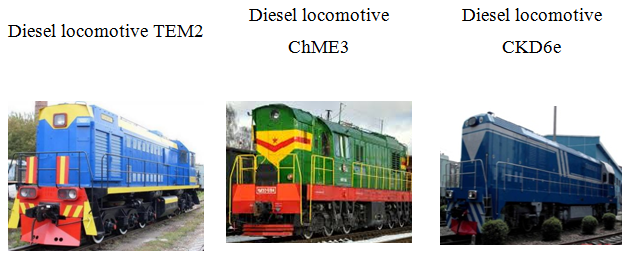
Fig. 1 – Shunting diesel locomotives, operating on Kazakhstan Railways
Table 1 – Main technical data of shunting diesel locomotives
| № | Technical parameters | Series of locomotives | ||
| TEM2 | ChME3 | CKD6e | ||
| 1 | Capacity concerning diesel Ne, kW | 882 | 992 | 995 |
| 2 | Axle formula | 3о-3о | 3о-3о | 3о-3о |
| 3 | Adhesive weight Рadh, kN | 1176 | 1205 | 1226 |
| 4 | Maximum traction power, Fmax, kN | 196 | 200,8 | 225 |
| 5 | Constructive speed Vmax, km/h | 100 | 95 | 80 |
| 6 | Specific effective fuel consumption ge, g/kW·h | 224 | 220 | 220 |
| 7 | Calculating speed VCal, km/h | 11 | 11,4 | 9 |
| 8 | Coefficient of beneficial use of diesel, фben | 0,7 | 0,72 | 0,74 |
| 9 | Tangent capacity NT, kW | 616,6 | 726,3 | 714,4 |
| 10 | Traction power of continuous regime Fcr, kN | 200 | 225,6 | 274 |
General quantity of diesel fuel, spent by locomotives is calculated basing on diesel consumption according to types of performing works
![]() (1)
(1)
here: Gi – diesel consumption by shunting locomotives according to types work (freight, passenger, shunting and household works), kg.
Generally accepted criteria of effective usage of diesel locomotives is specific diesel consumption for measurer 10 000 t. km. total (brutto)
![]() (2)
(2)
here: А – annual volume of performed types of works by diesel locomotives according to types of works, mln. t. кm. Brutto (total);
Scope of work by diesel locomotives JSC «Locomotive» in 2015 is 208 264,6 mln. t. km. brutto (total) (pic 2), for performing of which is consumed 727 117 ton of diesel with average specific diesel consumption 34,9![]() (fig. 2).
(fig. 2).
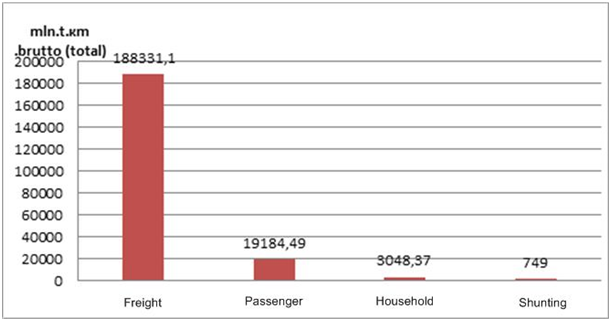
Fig. 2 – Annual work, performed by diesel locomotives according to types of movements
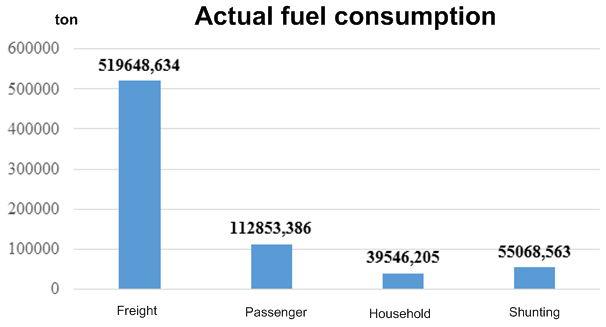
Fig. 3 – Actual fuel consumption by diesel locomotives according to types of movement
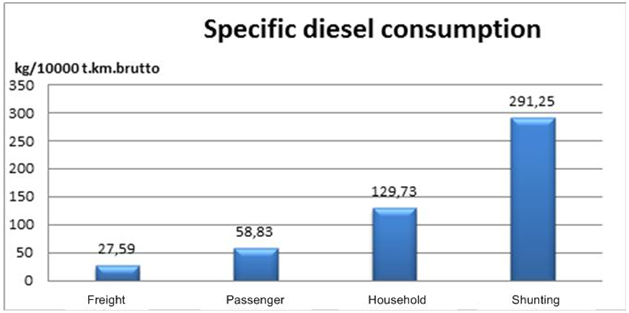
Fig. 4 – Specific diesel consumption by diesel locomotives according to types of movements
Effectiveness of diesel locomotive capacity usage is defined by usage coefficient Diesel Generator Set – К.
![]() (3)
(3)
![]() - capacity on intermediate regime, кW;
- capacity on intermediate regime, кW;
![]() - nominal capacity, кW
- nominal capacity, кW
Actual problems
Loads of diesel generator set of shunting locomotives on different types of work which have following average meanings:
- in freight К = 0,7 ÷ 0,9;
- in passenger К = 0,5 ÷ 0,7;
- in household К = 0,3 ÷ 0,4;
- in shunting К = 0,2÷0,3.
The data points out at non-economical regimes of work of diesel locomotives, especially at shunting-household activity.
Characteristic peculiarity of shunting diesel locomotives operation is non-load running and small loads which are 60÷75 % of general duration of its work, nominal regime diesel generator set is 1,5 % of diesel locomotive total time [1, 2].
Such distribution in some other types of work [3-5]. It is defined by conditions of train and shunting work conditions, and also by temporary (season) factors. Diesel consumption on regimes of non-load running of diesel which is 30÷50 % of total diesel consumption in operation [1]. As a result specific diesel consumption of shunting locomotives is exceeding meanings of specific consumption of main line diesel locomotives in freight work in the amount of 10,6 times (fig. 4).
Exceeding diesel consumption is not the only negative consequence of traction work on small load regimes and in a no-load running. In parallel there is intensive carbon accumulation in turbo compressor, that leads to rotor disbalance, reducing of productivity and air pressure and as a sequence, to increasing wear of mounting bearings of turbo compressor, diesel consumption increasing by traction in all capacity diapason, increased heat density of cylinder-reciproating group and increasing of emissions release into the atmosphere. Currently, big number of projects concerning reducing of diesel consumption by traction of shunting locomotive in a non-load running during hot downtime is proposed, reducing of carbon accumulation for the cost of reducing corrective periods of turbo compressor or injection of water inside of it and other. [5]. Significant reducing of operational coefficient of effectiveness and consequently, big diesel consumption by shunting diesel locomotives, appearing with low temperatures of environment air. Danger of water freezing in the cooling system and high oil viscosity with low temperatures do not allow simply to shut-off engine. To use antifreeze in current diesels economically and constructively not possible. There is enough many different heating systems of shut-off diesel. For example, big distribution got the system of American company Kim Hotstart, where the main source of heating is electrical heating tube ( EHT) set in the cooling diesel system and supplied from additional Diesel Generator Set (DGS) of not big capacity [6].
Materials and Methods
Autonomous heating system of diesel «Golfstrim», developed by the company «Dalway Management» [3, 7], acting as source of heating are used boiler heat exchangers (energy of diesel combustion is at once transforms into the heating).
Essential deviation of this system is:
- their low coefficient of productivity for the cost of energy conversion;
- necessity of frequent maintenance of additional Diesel Generator Set (DGS).
- appliance of additional set, necessary for oil heating on carter diesel.
Main consumptive part on diesel locomotives, it is diesel traction.
Analysis of chronometric data demonstrates that:
- at first - no-load running when they correspond to the awating of work by diesel locomotive and it means the diesel locomotive is.
- at second– nominal capacity (for example 880 kW of diesel PD1M – of locomotive ТEМ2) mostly is not used, it means that Diesel Generator Set (DGS) of shunting locomotives is operating with very low coefficient of load.
The most optimal solution of diesel consumption redicung on shunting locomotives– it turns down diesel during awaiting for work by diesel locomotive. In parallel emissions release by diesel locomotive is reducing.
Diesel usage on shunting diesel locomotives with dry carter allows to solve the problem of diesel stop and provide heat its condition support. There is experience in diesel railway operation with dry carter on diesel locomotives with hydro mechanical transmission.
Principal work scheme of diesel cooling system with dry carter concerning innovative patent [8, 9] is given on fig. 2.
The main condition of diesel stop in the course of winter is providing support of water temperature in diesel cooling system, it means that heating and water circulation is provided by the following:
- diesel locomotive work in standard operation – water circulation is carried out by main water pump;
- diesel turned off – water circulation in cooling system is carried out by additional pump from energy source (site а-4-4-b).
Turned off diesel and oil in separate oil tank are heated by warm water in specific heating boiler operating on diesel.
Water circulation is carried out according to contour – diesel – radiators – heat boiler – additional pump – oil tank – cooler of boosted air -diesel. Oil from oil tank into diesel back to the tank is transferred through pipe system by oil pumps. (fig. 5).
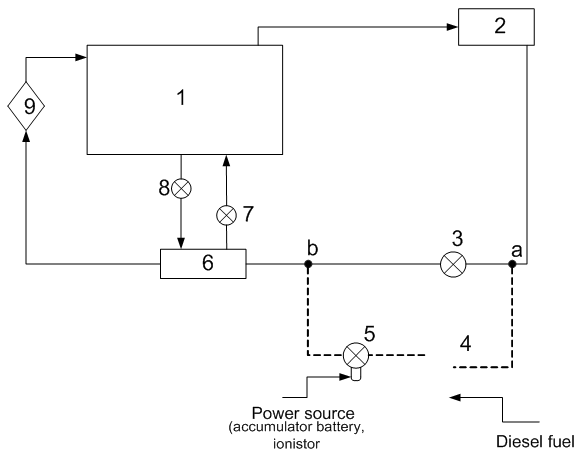
Fig. 5 – Scheme of work of diesel cooling system with dry carter:
1-diesel, 2 – cooling radiators, 3 – main water pump, 4-water boiler heater, 5- additional water pump, 6 – oil tank, 7- oil booster pump, 8 – oil drain pump, 9 – cooler of boosted air
Electromotor of circular pump 5 is supplied from power supply – energy accumulator (energy accumulator or pseudocapacitor). With launched diesel, into storage oil tank receives cooling water in radiators, which makes oil cool.
Discussion and Results
Effectiveness estimation of boiler heating for keeping of diesel locomotive heat condition is defined by help of comparison of diesel consumption at idle speed and diesel consumption necessary for boiler heating work [10], [11].
Necessary heat amount for traction:
![]() (4)
(4)
here: Сd –conditional diesel heat capacity, kilojoule/degree
![]()
here: Сmet, сoil, сliq – conditional heating capacity consequently of metal, oil, cooling liquid, kilojoule/kg·degree;
Мmet,, Мoil,, Мliq - mass consequently of metal, oil, cooling liquid (water).
ΔТ – necessary size of traction heating, ![]()
tmain b.– temperature main bearings will be equal to –200С,
to – start traction temperature, will be equal to –40оС
t – duration of traction heat preparation,
α – coefficient of heat loss from traction surface into the environment (depending on wind speed and quality of warmth-keeping devices of traction is accepted within limits 15…80 kilojoule/m2·h·degree),
F – surface of cooling traction surface, m2:
![]()
here i – number of traction cylinders,
D, S- consequently, diameter and engine stroke,
Кsur – coefficient, taking into account active surface of traction, is equal to 1,25…1,3.
According to found heat producing capacity of it, it is necessary to check head cylinder block temperature in the end of.
![]()
here Сhead conditional heating capacity of cylinder head,
![]()
В – constant coefficient acceptable for head of iron – 0,45, аluminium floating – 0,5.
Control of temperature condition of diesel fading is carried out by the temperature of cylinder head, which must be no more than 40оС [12].
Diesel consumption on traction heating with definite temperature of environment at specific:
![]()
Hu – heating diesel effect (for diesel 42,5·103 kilojoule/kg),
ηп – coefficient of productivity of heater.
Control of temperature condition of turned off diesel is carried out by temperature of cylinder head, which has to be no less than 40оC .
Upon receiving of work performance order, driver starts up diesel, driver starts diesel locomotive movement.
Conclusion
- The timing analysis showed that the specific consumption of diesel locomotives in shunting operations exceeded the value of the specific consumption of diesel locomotives in train operation by 10.6 times, and the load factor of the engine exceeded K = 0.2 ÷ 0.3.
- The possible solution to this problem is by using diesel engine with dry crankcase as power installation of the diesel locomotive according to an innovative patent. № 31244, it will allow to maintain the thermal state of the muffled main diesel engine during cold weather, thereby reducing fuel consumption and emission of harmful substances with exhaust gases at idle.
Список литературы / References
- ГапановичВ.А. Энергосбережение на железнодорожном транспорте / В.А. Гапанович, В.Д. Авилов, и др. // М.: Изд. Дом МИСиС. – 2012. – 620 с.
- Hoimoja H. Modernisation Issues of Diesel-Electric Shunting Locomotive Power Units [Electronic resource] / H. Hoimoja, T. Jalakas, A. Rosin, A. Rassylkin // Scientific Journal of Riga Technical University. – 2010. – Vol. 27, P. 57-62. - www.degruyter.com/view/j/ecce.2010.26.issue.
- Молчанов А.И. Автоматизированная система учета, контроля и анализа расхода топлива маневровыми тепловозами / А.И.Молчанов, И.Л. Поварков, Л.А. Мугинштейн, К.М. Попов // Вестник «ВНИИЖТ» – 2004. №2. С. 25-29.
- Abdullayev S. The determination of admissible speed of locomotives on the railway tracks of the Republic of Kazakhstan / S. Abdullayev, N. Tokmurzina, G. Bakyt // Transport Problems International scientific journal – 2016. Vol. 11 – № 1, P. 61-68.
- Kato T. Development of CNG fueled engine with lean burn for small size commercial van / T. Kato, K. Saeki, H. Nishide, T. Yamada // JSAE Review – 2001. Vol. 22 – №3, P. 365–368.
- Володин А.И. Комплексный анализ термодинамических, экономических и экологических характеристик тепловозных дизелей в условиях эксплуатации / А.И. Володин, Е.И. Сковородников, А.С. Анисимов // Омск: ОмГУПС. – 2011. – 165 с.
- Dorado M.P. Exhaust emissions from a diesel engine fuelled with transesterified waste olive oil / M.P. Dorado, E. Ballesteros, J.M. Arnal, J. Gomez, F.J. Lopez // Fuel – 2003. Vol. 82 – №11, P. 1311-1315.
- Просвиров Ю.Е. Инновационные энергосберегающие технологии в локомотивном хозяйстве / Ю.Е. Просвиров, А.В.Муратов, С.А. Петухов //: Самара: СамГУПС. – 2012. – 123 с.
- Albert, R.E. Comparative potency method for cancer risk assessment: application to diesel particulate emissions / R.E. Albert, J. Lewtas, S. Nesnow, T.W. Thorslund, E. Anderson // Risk Analysis an international journal – 1983. Vol. 3 – №2, P. 101–117.
- Barone T.L. An analysis of direct-injection spark-ignition (DISI) soot morphology / T.L.Barone, J.M.E. Storey, A.D. Youngquist, J.P. Szybist // Atmos. Environ – 2012. №49, P. 268–274.
- Мусабеков М.О. Маневровый тепловоз / М.О.Мусабеков, Г.Б. Бакыт, А.М. Омирбек // Инновационный патент №31244, дата регистрации в Госреестре Республики Казахстан от 16.02.2016.
- Володин А.И. Методы оценки технического состояния, эксплуатационной экономичности и экологической безопасности дизельных локомотивов / А.И.Володин// М: Желдориздат. – 2007. – 264 с.
Список литературы на английском языке / References in English
- Gapanovich V.A. Energosberezhenie na zheleznodorozhnom transporte [Energy saving in railway transport] / V.A. Gapanovich, V.D. Avilov and other. // M.: Izd. Dom MISiS. – 2012. – 620 p. [in Russian]
- Hoimoja H. Modernisation Issues of Diesel-Electric Shunting Locomotive Power Units [Electronic resource] / H. Hoimoja, T. Jalakas, A. Rosin, A. Rassylkin // Scientific Journal of Riga Technical University. – 2010. – Vol. 27, P. 57-62. - www.degruyter.com/view/j/ecce.2010.26.issue.
- Molchanov A.I. Avtomatizirovannaya sistema ucheta, kontrolya i analiza rashoda topliva manevrovymi teplovozami [Automated system for accounting, control and analysis of fuel consumption by shunting locomotives] / A.I. Molchanov, I.L. Povarkov, L.A. Muginshtejn, K.M. Popov // Vestnik «VNIIZHT» – 2004. №2. P. 25-29. [in Russian]
- Abdullayev S. The determination of admissible speed of locomotives on the railway tracks of the Republic of Kazakhstan / S. Abdullayev, N. Tokmurzina, G. Bakyt // Transport Problems International scientific journal – 2016. Vol. 11 – № 1, P. 61-68.
- Kato T. Development of CNG fueled engine with lean burn for small size commercial van / T. Kato, K. Saeki, H. Nishide, T. Yamada // JSAE Review – 2001. Vol. 22 – №3, P. 365–368.
- Volodin A.I. Kompleksnyj analiz termodinamicheskih, ekonomicheskih i ekologicheskix xarakteristik teplovoznyx dizelej v usloviyah ekspluatacij [Complex analysis of thermodynamic, economic and ecological characteristics of diesel diesel engines under operating conditions] / A.I. Volodin, E.I. Skovorodnikov, A.S. Anisimov // Omsk: OmGUPS. – 2011. – 165 p. [in Russian]
- Dorado M.P. Exhaust emissions from a diesel engine fuelled with transesterified waste olive oil / M.P. Dorado, E. Ballesteros, J.M. Arnal, J. Gomez, F.J. Lopez // Fuel – 2003. Vol. 82 – №11, P. 1311-1315.
- Prosvirov Iu.E. Innovacionnye energosberegayushie tehnologii v lokomotivnom hozyajstve [Innovative energy-saving technologies in the locomotive sector] / Iu.E. Prosvirov, A.V. Muratov, S.A. Petuhov //: Samara: SamGUPS. – 2012. – 123 p. [in Russian]
- Albert, R.E. Comparative potency method for cancer risk assessment: application to diesel particulate emissions / R.E. Albert, J. Lewtas, S. Nesnow, T.W. Thorslund, E. Anderson // Risk Analysis an international journal – 1983. Vol. 3 – №2, P. 101–117.
- Barone T.L. An analysis of direct-injection spark-ignition (DISI) soot morphology / T.L.Barone, J.M.E. Storey, A.D. Youngquist, J.P. Szybist // Atmos. Environ – 2012. №49, P. 268–274.
- Musabekov M.O. Manevrovyj teplovoz [Shunting locomotive] / M.O. Musabekov, G.B. Bakyt, A.M. Omirbek // Innovative patent №31244, the date of registration in the State Register of the Republic of Kazakhstan from 16.02.2016.
- Volodin A.I. Metody ocenki tehnicheskogo sostoyaniya, ekspluatacionnoj ekonomichnosti i ekologicheskoj bezopasnosti dizelnyh lokomotivov [Methods for assessing the technical condition, operational efficiency and environmental safety of diesel locomotives] / A.I.Volodin// M: Zheldorizdat. – 2007. – 264 p.
